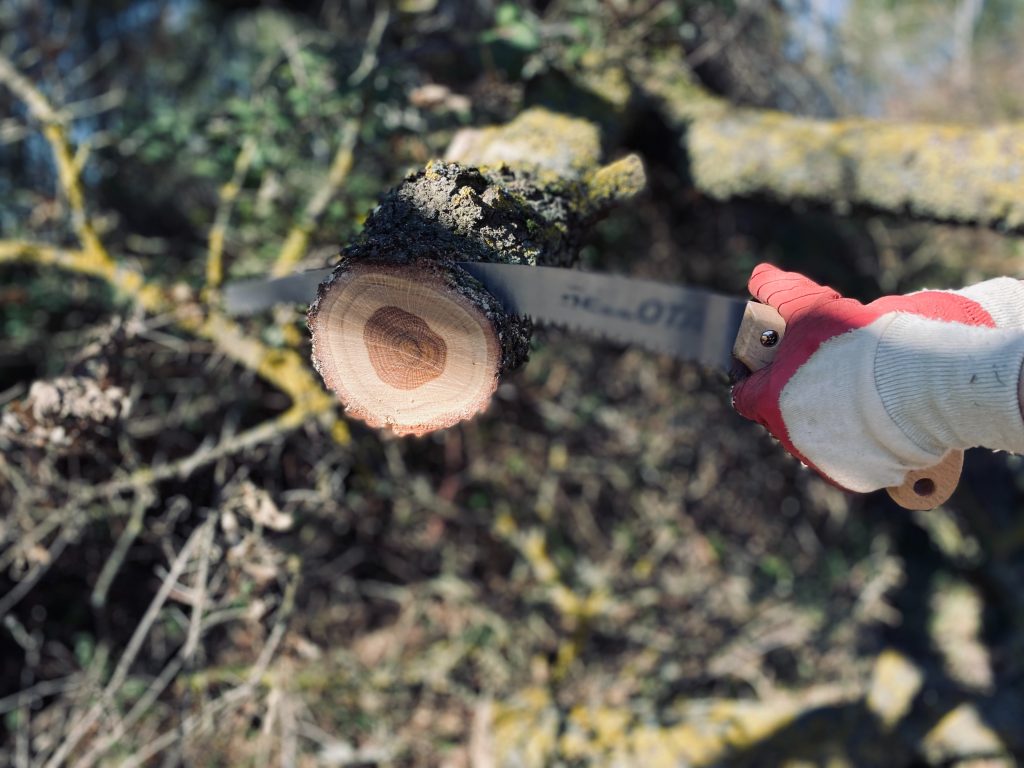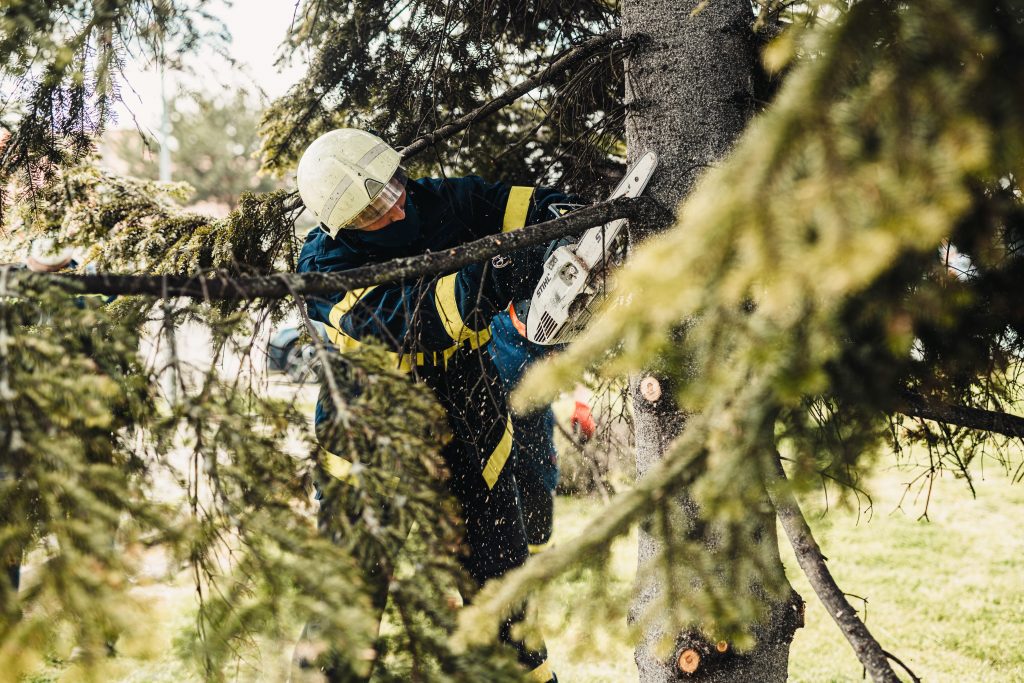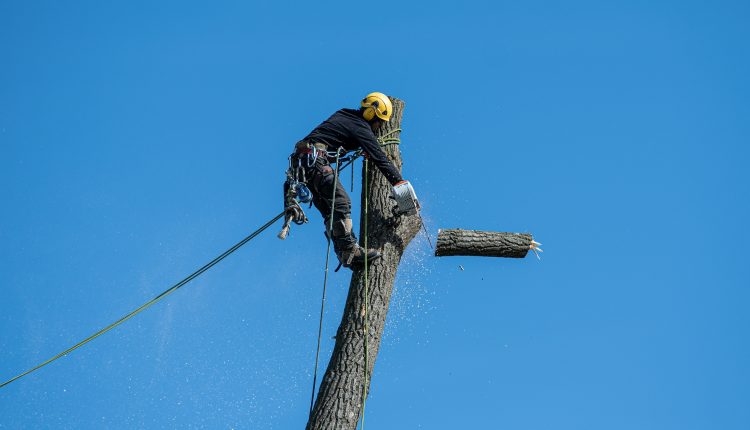CORRECTING COMMON TREE PRUNING MISTAKES
Common tree pruning mistakes are errors that homeowners and inexperienced individuals often make when attempting to prune trees. These mistakes can have detrimental effects on tree health, structure, and aesthetics. Understanding these mistakes is crucial for maintaining the well-being of your trees and promoting proper tree care. Here’s an explanation of some common tree pruning mistakes:

1. Topping and Over-Pruning:
• Mistake: Topping involves severely cutting back the main branches or leader of a tree, resulting in a stub-like appearance.
• Effects: Topping weakens the tree’s structure, promotes weak regrowth, and exposes the tree to diseases and pests.
• Correction: Selective branch removal and crown reduction techniques should be used instead of topping to maintain a healthy canopy structure.
2. Improper Timing:
• Mistake: Pruning at the wrong time of year can stress trees and hinder their growth.
• Effects: Pruning at the wrong time can result in reduced flowering, fruiting, and overall tree vigor.
• Correction: Prune trees during their dormant periods or specific growth stages according to their species.
3. Lion’s Tail Pruning:
• Mistake: Lion’s tail pruning involves removing inner branches and foliage, leaving only growth at the ends of branches.
• Effects: This practice disrupts the natural balance of the tree, weakens branch attachments, and increases the risk of branch failure.
• Correction: Maintain a balanced distribution of foliage along branches to prevent excessive weight and strain on the tree’s structure.
4. Improper Cuts:
• Mistake: Making improper cuts, such as flush cuts (cutting too close to the trunk) or leaving stubs, can harm the tree.
• Effects: Improper cuts can lead to decay, diseases, and hinder proper wound healing.
• Correction: Use proper cutting angles and techniques, leaving the branch collar intact when removing branches.
5. Removing Too Many Healthy Branches:
• Mistake: Over-pruning by removing too many live branches can stress the tree and compromise its ability to produce energy.
• Effects: Reduced foliage reduces the tree’s capacity to perform photosynthesis, weakening its overall health.
• Correction: Practice selective pruning, removing only dead, diseased, or poorly structured branches while retaining healthy foliage.
6. Using Improper Tools:
• Mistake: Using inappropriate or dull tools can result in ragged cuts and bark damage.
• Effects: Improper tools can injure the tree and hinder proper healing of pruning wounds.
• Correction: Use sharp, clean tools that are appropriate for the size and type of branches being pruned.
7. Over-Pruning in a Single Session:
• Mistake: Removing a large portion of a tree’s canopy in a single session can cause stress and shock.
• Effects: Over-pruning can lead to reduced growth, increased susceptibility to pests and diseases, and even tree decline.
• Correction: Gradually prune over several seasons to minimize stress on the tree.
8. Lack of Knowledge and Experience:
• Mistake: Pruning without proper knowledge or experience can result in unintended damage to the tree.
• Effects: Inadequate pruning can negatively impact tree health, structure, and aesthetics.
• Correction: Educate yourself about proper pruning techniques or consult with certified arborists for guidance and assistance.
Avoiding these common pruning mistakes and following proper pruning practices is essential for maintaining the health, appearance, and longevity of your trees. If in doubt, seek guidance from certified arborists who possess the expertise to perform correct pruning techniques that benefit both your trees and your property.
Importance Of Proper Tree Pruning For Tree Health And Aesthetics
Proper tree pruning is essential for maintaining the health, structure, and aesthetics of trees. Pruning involves the selective removal of specific branches or parts of a tree to achieve various objectives, such as promoting growth, improving shape, and enhancing overall well-being. Here’s an explanation of the importance of proper tree pruning for both tree health and aesthetics:

1. Tree Health:
A. Disease and Pest Management:
• Proper pruning helps remove dead, diseased, or infested branches, preventing the spread of pests and diseases to other parts of the tree.
• Pruning increases airflow and sunlight penetration, creating an environment that is less favorable for fungal growth and other pathogens.
B. Wound Healing:
• Correct pruning techniques minimize the size of wounds, enabling the tree to compartmentalize and heal more effectively.
• Proper cuts reduce the risk of decay and infection, promoting long-term tree health.
C. Structural Integrity:
• Pruning removes weak, crossing, or poorly attached branches that could pose safety hazards or lead to future failure.
• By improving branch attachments and reducing the risk of splitting, proper pruning enhances the tree’s overall stability.
D. Growth Promotion:
• Targeted pruning stimulates new growth by directing energy to specific areas, fostering healthier and more vigorous branches.
• Removing excessive branches allows the tree to allocate resources to existing foliage, improving overall vitality.
E. Rejuvenation:
• Thinning cuts and selective branch removal can rejuvenate older trees by encouraging the growth of new, healthier branches.
• This can revitalize the tree’s appearance and improve its ability to produce leaves and flowers.
2. Aesthetics and Landscape Value:
A. Shape and Structure:
• Proper pruning enhances the tree’s natural form, creating a more aesthetically pleasing and balanced appearance.
• Well-pruned trees contribute to a visually appealing landscape that enhances the overall value of the property.
B. Clearance and Safety:
• Pruning removes lower branches that may obstruct sidewalks, driveways, or line of sight for vehicles and pedestrians.
• Elevating the canopy improves safety and reduces the risk of property damage during storms.
C. Views and Light Penetration:
• Pruning selectively opens up views by removing obstructing branches, creating better sightlines and vistas.
• Trimming branches also improves sunlight penetration, benefiting the growth of grass, plants, and other vegetation beneath the tree.
D. Controlled Growth:
• Pruning controls the size of trees in urban environments, preventing overcrowding and ensuring they don’t outgrow available space.
• This prevents trees from interfering with structures, utility lines, and neighboring properties.
Proper tree pruning is a fundamental practice that influences both the health and aesthetics of trees. By following correct pruning techniques, you contribute to the longevity, resilience, and beauty of your trees while also ensuring the safety and functionality of your property. For more complex pruning tasks or if you’re uncertain about how to proceed, it’s advisable to seek guidance from certified arborists who possess the expertise to achieve optimal results for your trees.
Common Mistakes Made During Tree Pruning
Tree pruning is a skill that requires careful consideration and knowledge to ensure the health and appearance of trees. However, several common mistakes are often made during tree pruning, which can have negative consequences for tree health and aesthetics. Here’s an explanation of these common mistakes:
1. Topping:
• Mistake: Topping involves cutting off a tree’s main branches or leader, leaving stubs.
• Effects: Topping weakens the tree’s structure, leads to rapid regrowth of weak, poorly attached branches, and exposes the tree to disease and pests.
2. Over-Pruning:
• Mistake: Over-pruning involves removing an excessive amount of foliage and branches.
• Effects: Over-pruning stresses the tree, reduces its ability to photosynthesize and produce energy, and weakens its overall health.
3. Lion’s Tail Pruning:
• Mistake: Lion’s tail pruning removes inner branches and foliage, leaving growth only at the branch ends.
• Effects: This practice weakens branch attachments, increases the risk of branch failure, and disrupts the natural balance of the tree.
4. Improper Cutting Techniques:
• Mistake: Using improper cutting angles, making flush cuts (too close to the trunk), or leaving stubs.
• Effects: Improper cuts can lead to bark damage, decay, and hinder the tree’s ability to heal properly.
5. Incorrect Timing:
• Mistake: Pruning at the wrong time of year, such as during active growth, can stress the tree.
• Effects: Incorrect timing can result in reduced flowering, fruiting, and overall tree vigor.
6. Removing Too Many Live Branches:
• Mistake: Removing too many healthy branches reduces the tree’s ability to perform photosynthesis.
• Effects: Reduced foliage limits energy production, weakens the tree, and can lead to decline over time.
7. Using Improper Tools:
• Mistake: Using dull or inappropriate tools can result in ragged cuts and damage to the tree.
• Effects: Improper tools can harm the tree and hinder proper healing of pruning wounds.
8. Drastic Pruning in a Single Session:
• Mistake: Removing a large portion of a tree’s canopy all at once can stress the tree.
• Effects: Drastic pruning can lead to shock, reduced growth, and increased vulnerability to pests and diseases.
9. Pruning Near the Branch Collar:
• Mistake: Cutting too close to the branch collar (swollen area where the branch connects to the trunk).
• Effects: Pruning at the collar allows for proper healing, while cutting into the collar can hinder wound closure.
10. Ignoring Tree Species Specifics:
• Mistake: Failing to consider the specific needs of different tree species during pruning.
• Effects: Each species has unique growth patterns and requirements, and incorrect pruning can harm the tree’s health.
Avoiding these common mistakes and following proper pruning techniques is essential for maintaining the health, appearance, and longevity of your trees. If you’re unsure about how to prune your trees, it’s recommended to consult with certified arborists who have the expertise to ensure the best outcomes for your trees and landscape.


Comments are closed.